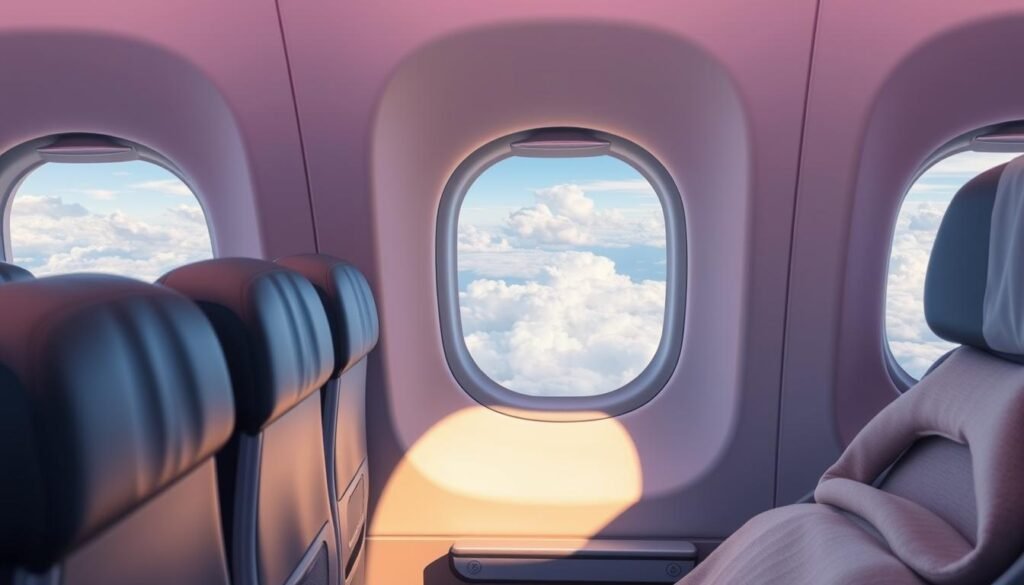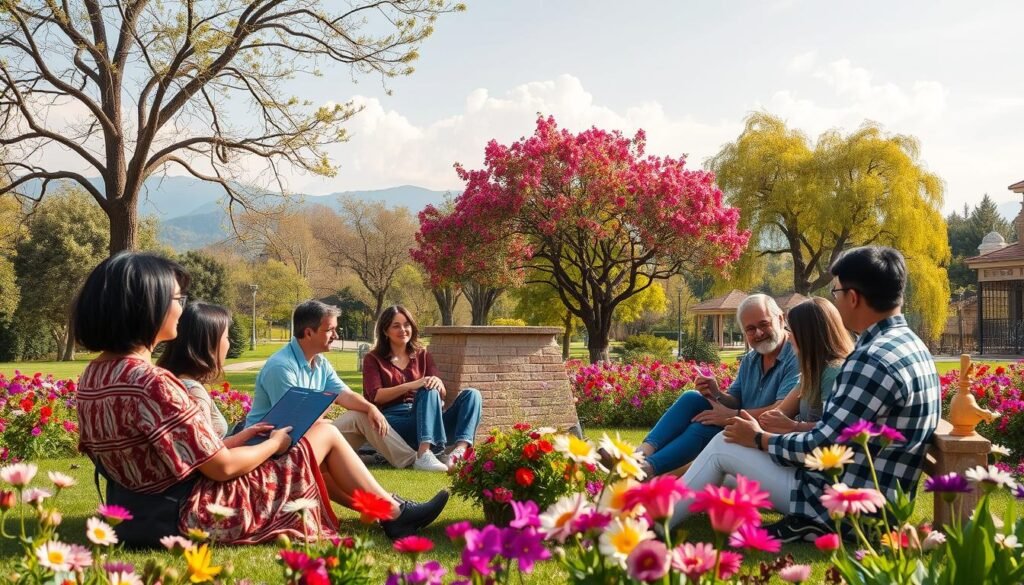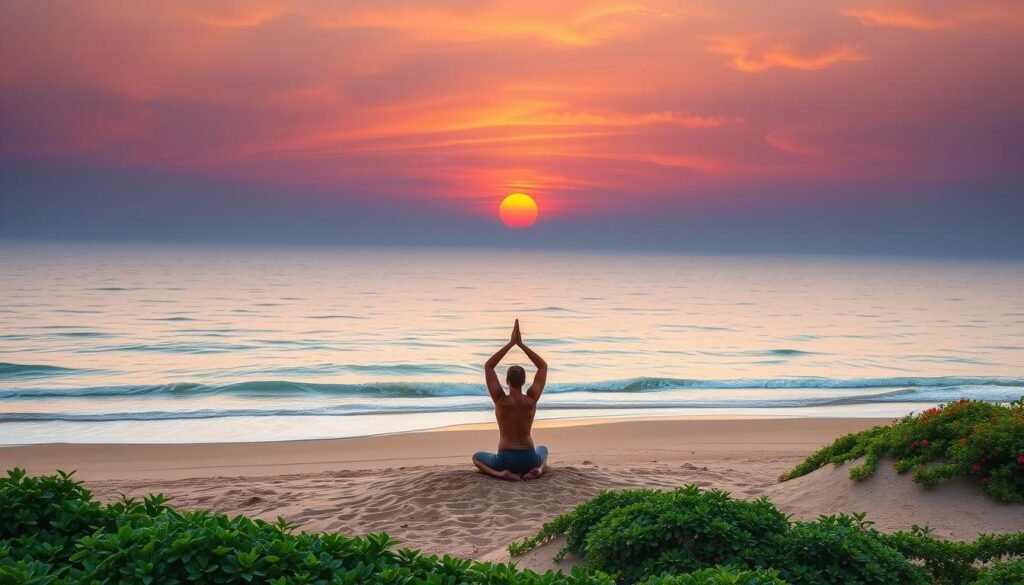Did you know that 30% of travelers feel anxious before or during their trips? This fact shows how common anxiety is when traveling. Anxiety can make it hard to enjoy new places. Fear of flying, being in new places, or planning pressures can dim the joy of travel. Learning to handle this stress is key to enjoying adventures fully.
This article will help you learn how to travel without anxiety. We’ll cover how to overcome fear and stress. Tips include finding out what makes you anxious and using planning strategies. For serious anxiety, therapy and medicine can also help. To get more tips on beating travel anxiety, check out this guide.
Key Takeaways
- Travel anxiety affects about 30% of travelers.
- Common triggers include fear of flying and being out of comfort zones.
- Preparation techniques can significantly help manage travel stress.
- Mindfulness and relaxation methods are beneficial during journeys.
- It’s essential to seek support from companions and professionals if needed.
Understanding Travel and Anxiety
Travel anxiety includes many feelings like fear and stress about traveling. It often shows up as a travel phobia. People with this issue may feel a lot of emotional pain in different situations. This makes it hard for them to enjoy or even start trips. Knowing what causes travel anxiety and how to deal with it can help people beat it. This leads to happier travel experiences.
What is Travel Anxiety?
Travel anxiety is when people feel uneasy or panic about traveling. It comes from many fears. For instance, fear of flying, worry about getting around in new places, or fear for personal safety. These fears can cause panic attacks. So, it’s key for people with bad travel anxiety to get help or advice from experts. Knowing about these issues is the first step to handle them well.
Common Triggers of Travel Anxiety
The reasons for travel anxiety differ from person to person. Some common triggers are:
- Crowded airports and busy terminals
- Delayed flights and transportation problems
- Long waits for boarding or customs
- Being in new places and feeling uncertain
Even little things, like not having control over parts of the trip, can make anxiety worse. Spotting these triggers is key in beating travel anxiety. It helps people find ways to reduce stress.
Recognizing Symptoms of Travel Anxiety
Knowing the signs of travel anxiety can make your trips better. It lets you deal with worries before they get big, making trips more fun. Symptoms can be both body and mind-related, showing how anxiety appears in various ways.
Physical Symptoms
Travel anxiety’s physical signs can pop up in different forms, often causing worry right away. These signs can be:
- Increased heart rate
- Shortness of breath
- Excessive sweating
- Nausea or stomach upset
Some people might not realize these are signs of an anxiety problem. Knowing them early can help manage them better.
Emotional Symptoms
Emotional signs often come with the physical ones. You might feel:
- Heightened irritability
- Restlessness affecting pre-trip plans
- A strong fear of not being in control
- Worrying too much about the trip and outcomes
It’s crucial to understand and recognize these emotional signs. Seeing them can help you find ways to feel better when traveling.
Overcoming Travel Anxiety: Practical Strategies
To tackle travel anxiety, start with preparation and calming techniques. These steps help you manage your anxiety better during trips. Preparation, mindfulness, and relaxation are key. They can truly change how you feel.
Preparation Techniques
Start by planning your trip well. Learn about where you’re going to understand what to expect. This includes customs, the weather, and key places. Knowing what travel documents you need can ease your worries. Making a list of what to pack ensures you won’t forget anything important.
Mindfulness and Relaxation Methods
Mindfulness can help you gain control over your feelings. Deep breathing focuses your mind and calms you down. Practicing meditation and yoga can improve your mental and physical health. These activities lower your anxiety before and during your travels.
Managing Travel Stress Before Your Trip
Managing travel stress starts well before you leave. Creating a detailed plan helps travelers set their schedule, stays, and fun activities. This order makes people feel they are in charge. This feeling lowers worry. Packing well also cuts stress, preparing travelers for different situations while away.
Creating an Itinerary
Making a full itinerary acts like a travel guide, showing the way each day. When planning, here’s what to keep in mind:
- Research Destinations: Look up information on places to see, eat, and the local culture.
- Outline Daily Activities: Plan time for major spots while staying open to unplanned fun.
- Include Travel Logistics: Write down how you’ll get there, when to leave, and any transfers.
- Accommodation Details: Keep records of where you’ll stay and when to check in and out.
Packing Tips to Reduce Anxiety
Packing well makes travel easier and less stressful. Here are tips to help:
- Make a Packing List: Write down everything you need, like clothes, toiletries, and papers, so you don’t forget anything.
- Pack Light: Bring fewer clothes by choosing items you can wear in different combinations.
- Use Packing Cubes: Organize your stuff in cubes or bags to find things easily.
- Prepare for Security: Keep liquids and electronics where you can quickly get them for security checks.
Using these methods will make your trip better and reduce stress. Good preparation leads to a smoother trip and fun times ahead.
Coping Strategies for Travel Anxiety During Your Journey
Traveling can make you feel anxious. It’s key to have good ways to cope with this anxiety. Try breathing exercises and finding distractions to make your trip more fun.
Breathing Exercises to Calm Nerves
Breathing right is a strong way to beat travel nerves. Use the 4-7-8 breathing trick:
- Inhale deeply through the nose for 4 seconds.
- Hold the breath for 7 seconds.
- Exhale slowly through the mouth for 8 seconds.
This breathing rhythm helps you relax and lessens stress. Using breathing exercises during tough times makes your trip calmer.
Distraction Techniques While Traveling
Distraction helps change your focus while on the move. Doing things you enjoy takes your mind off stress. Here’s what you can do:
- Listening to music or podcasts.
- Reading a great book or article.
- Doing puzzles or playing games on your phone.
These distraction techniques change your outlook and help you enjoy traveling. Mix these approaches for better anxiety management when you’re in new places.
Dealing with Flight Anxiety
Flying can make many people feel really uneasy. Knowing how to tackle these feelings is key to enjoy flying. Here are some tips that can help you fly calmly. They will teach you how to manage flight anxiety effectively.
Tips for a Calmer Flying Experience
- Book Direct Flights: Direct flights reduce anxiety. They cut down on layovers and delays.
- Select Comfortable Seats: Choose seats with more legroom or ones at the front. These spots are quieter.
- Engage in Calming Practices: Deep breathing or thinking of a peaceful place helps lower stress before and during your flight.
- Light Meals: Eating lightly helps avoid feeling uncomfortable. This can make you feel better overall when flying.
- Stay Hydrated: Drink water to stay hydrated. It fights off tiredness throughout the flight.
- Utilize In-Flight Entertainment: Watching movies, listening to music, or playing games can distract you from anxiety.
These tips aim to change how people experience flying. By following them, flying can become much more enjoyable.

Reducing Travel-Related Panic Attacks
Traveling can lead to intense anxiety for some. This can disrupt your journey. To reduce panic attacks while traveling, it’s important to know what triggers them. Also, you should know how to handle these situations if they happen. This makes your trip more enjoyable.
Identifying Triggers in Real-Time
It’s key to know what makes you anxious while traveling. Common causes of stress include:
- Busy airports or crowded terminals
- Unfamiliar locations and lack of landmarks
- High-pressure situations like missed flights
- Long delays or unexpected changes in plans
Knowing what bothers you can help. This way, you can dodge these stressors. This makes your travel experience more fun.
Emergency Techniques for Managing Panic Attacks
There are ways to calm down during a panic attack. These techniques can help:
- Grounding exercises: Pay attention to your surroundings. Describe different things you can sense around you.
- Focusing on breathing: Breathe in slowly through the nose, hold, and breathe out through the mouth.
- Visualization: Imagine being in a peaceful place. This can help you relax.
Using these methods can make a big difference. They let you manage your anxiety while on the go.
Finding Support for Travel Anxiety
Getting help for travel anxiety can make trips better. Traveling with friends offers comfort and reassurance. Everything is easier to handle when feelings are shared. This creates a helpful environment for everyone.
Travel Companion Strategies
There are many ways to make your trip easier. It helps to travel with someone who gets how you feel. Having a support group makes the trip nicer. You can:
- Designate times just for relaxing.
- Do things together that calm you, like walks or deep breathing.
- Set times to talk about what makes you anxious.
- Use apps that help with relaxation.
These tips can help a lot. But, sometimes, more help is needed. If anxiety is too much, seeing a professional is a good idea. They can offer specific ways to feel better when traveling.
Consulting Professionals for Help
If your travel worries are big, talking to a therapist or counselor helps. They give advice and coping methods just for you. This helps figure out what triggers your anxiety and how to cope. For more tips, check out resources like this and this.

Calming Techniques for Anxious Travelers
Traveling often makes people anxious. However, there are methods to ease this anxiety. Using grounding exercises and tech can really improve the journey.
Grounding Techniques to Stay Present
Grounding methods are key to helping people feel connected to the moment. A common technique is the “5-4-3-2-1” exercise. This focuses on using your senses:
- Identify 5 things you can see.
- Identify 4 things you can touch.
- Identify 3 things you can hear.
- Identify 2 things you can smell.
- Identify 1 thing you can taste.
By connecting with the environment, this practice lowers anxiety. It also brings mindfulness.
Using Technology to Stay Calm
Today, there are many apps designed to help manage anxiety. These tools are a big help for travelers who feel anxious. Some key features include:
| App Name | Key Features | Best For |
|---|---|---|
| Headspace | Guided meditations, relaxation exercises | Mindfulness and stress relief |
| Calm | Soothing sounds, sleep stories | Improving sleep and relaxation |
| Simple Habit | Short meditations for busy travelers | Quick stress relief |
Using calming methods helps control anxiety during travel. Combining grounding techniques with tech makes travels smoother. It lets people enjoy new places feeling more relaxed.
Creating a Positive Travel Mindset
Building a positive travel mindset is essential for a great trip. It’s important to have realistic expectations and to be flexible. This way, you can reduce stress and enjoy your travels more. Knowing that things may not always go as planned helps keep a good attitude. This is especially true when facing unexpected situations.
Setting Realistic Travel Expectations
Having realistic expectations is key when traveling. Expect some challenges like delays or encountering new cultures. This prepares you emotionally. Keeping an open mind allows you to embrace new experiences without feeling disappointed.
Don’t seek perfection in your plans. This makes the adventure more enjoyable. For tips on handling travel anxiety, check out this helpful resource.
Embracing Flexibility During Travel
Being flexible can make your trip better. Changes in weather or plans can lead to unexpected fun. This lets you find hidden spots and learn about local cultures not in your original plan.
A positive attitude turns the stress of change into excitement. This can make your trip one to remember.

| Expectation Type | Realistic Approach | Benefits |
|---|---|---|
| Travel Delays | Plan for extra time | Reduces frustration |
| Cultural Differences | Research local customs | Enhances understanding |
| Budget Constraints | Prioritize key experiences | Maximizes enjoyment |
| Weather Changes | Pack for various conditions | Stays prepared |
Conclusion
Traveling is meant to be exciting. But for some, the thought of it brings anxiety. This article shared ways to make travel less stressful. By using these tips, you can lower your anxiety. And enjoy discovering new places.
Knowing how to handle your anxiety changes how you experience travel. Preparation, being mindful, and having realistic expectations help a lot. These strategies do more than just ease anxiety. They also make your trip more enjoyable and meaningful.
Don’t let fear stop you from exploring. Whether it’s a short trip or a long adventure, start your journey to stress-free travel. Check out moodcarehealth.com for more tips on managing travel stress. Go ahead, start your adventure, free from anxiety.